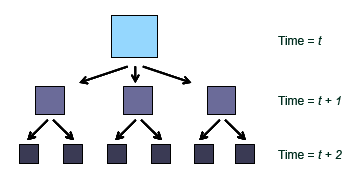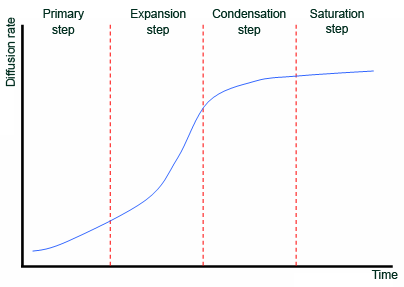|
|
Non-spatially dependent diffusion
In the ![]() non-spatially dependent diffusion process the spatial proximity is not influencing the
behaviour of the diffusion. The major factor is the hierarchy of each place
in space, such as the population size, or the economic, cultural or political
influences.
non-spatially dependent diffusion process the spatial proximity is not influencing the
behaviour of the diffusion. The major factor is the hierarchy of each place
in space, such as the population size, or the economic, cultural or political
influences.
![]() Hierarchical diffusion: where the
spatial diffusion occurs through an ordered sequence of classes or places
like the spread of AIDS from large urban centres to small towns.
Hierarchical diffusion: where the
spatial diffusion occurs through an ordered sequence of classes or places
like the spread of AIDS from large urban centres to small towns.
 Principle of non-spatially dependant Hierarchical diffusion at successive moments of time
Principle of non-spatially dependant Hierarchical diffusion at successive moments of time
Let us now concentrate on the spatially dependant diffusion process. We have seen that space can be modelled in different manners. If we admit that space cannot be considered as a homogeneous medium in the diffusion process, one should introduce a concept that characterises the specific influence of locations in the diffusion process. The concept of friction encompasses the overall specific properties of each location that influence the speed and the intensity of the diffusion process. In this way the spread can go through any place in space with more or less difficulties. The friction concept is expressing this level of difficulty.
In the theory of the spatial diffusion process, friction is considered as
a barrier to the diffusion of innovation. At each location and for each moment
during the diffusion process, the permeability level of a barrier can vary.
Abler, Adams and Gould (1972) identify three different effects resulting from
![]() barriers to the diffusion of innovation:
barriers to the diffusion of innovation:
- Absorbing barrier completely blocks a pulse of innovation.
- Reflecting barrier will redirect the energy of diffusion toward different directions, such as a water body, for the expansion of a city.
- Permeable barrier absorbs part of the energy but allows the rest to go through. Its effects will slow down the process in its local area of influence.
Local factors that act as barriers to the diffusion process are of three
types:
- Physical barriers that block or slow down the diffusion. They are physical properties of space such as the topography or the land cover.
- Cultural barriers can influence the diffusion of an innovation that spreads from individual acceptance. Linguistic, religious and political factors are typical cultural barriers to diffusion.
- Psychological barriers can be important for innovations involving individual acceptance in the process of diffusion. In this situation, individuals act as carriers in the diffusion process.
These concepts developed in the frame of the diffusion of innovation can
be applied to the diffusion of numerous phenomena.
The temporal framing of spatial diffusion follows a number of rules:
- Primary step of the process corresponds to the beginning of diffusion. At this stage, diffusion introduces a new differentiation inside geographical space; a contrast appears between places that have adopted the innovation and other places.
- Expansion step is the stage of actual development of the process that generates a gradual softening of the strongest contrasts between places.
- Condensation step, the rate of penetration into the different places tends to become more homogeneous, while speeds of diffusion in the various places grow closer.
- Saturation step is the final stage where the diffusion rate increases toward a maximum following an asymptotic curve.
The diffusion rate change throughout time is generally modelled with a logistic function (S-shaped function) as illustrated in next figure.
 Typical successive stages of diffusion rate during the diffusion process. For an innovation, they are
called Innovators, Early majority, Late majority and Laggards
Typical successive stages of diffusion rate during the diffusion process. For an innovation, they are
called Innovators, Early majority, Late majority and Laggards We now know most of the concepts and elements to understand the basic principles ruling spatial diffusion models, particularly those developed for the diffusion of innovation:
- The spatial expansion process is modelled with the component of friction that summarises the action of factors involved in the spatial interactions: distance, mass, barriers… Often contagious types of rules are combined with the hierarchical type, as both types are acting simultaneously.
- The densification in each location throughout time is controlled by the parameters of the logistic function.
Since the mid-sixties, when T. Hägerstrand had set-up the basis of the
spatial diffusion model (Hägerstrand 1967), many authors and scientists have
modelled the spatial diffusion of various phenomena such as technical
innovations, new ideas, new cultural or social behaviours, but also the
migration of persons or goods.
In his short paper, L. Frank (2002) clearly presents the application of a spatial diffusion model to the diffusion of mobile communications within the European Union. It is an interesting and illustrative application of spatial diffusion modelling.
